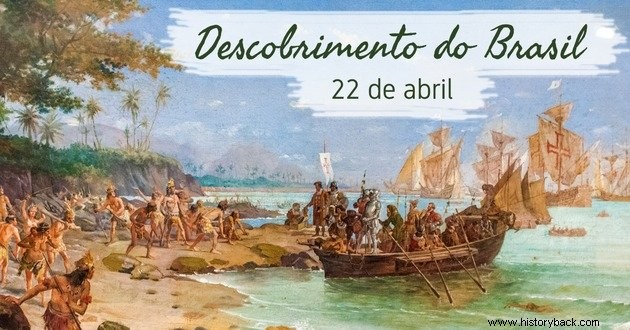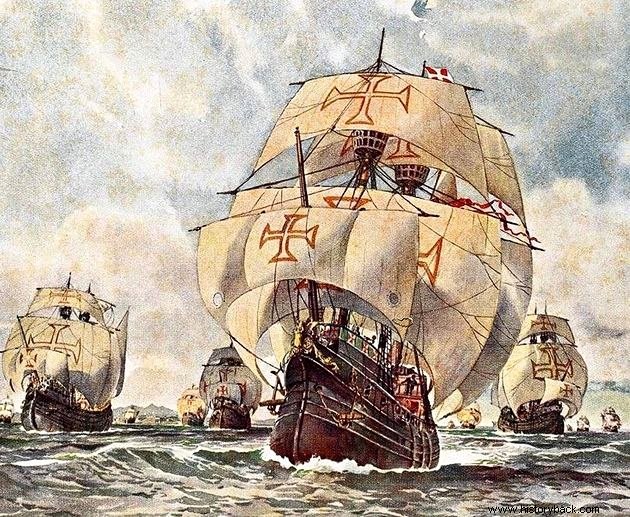The Brazil Discovery Day refers to the 22nd of April 1500, the date on which the Portuguese arrived in the lands that would later become Brazil.
Although not a holiday , the day is part of the Brazilian civic and school calendar.
Origin of the date of the discovery of Brazil
The date of the discovery of Brazil was not always celebrated on that day. One of the first names that Brazil received was Terra de Vera Santa Cruz. In order for the date to coincide with the Santa Cruz holiday, King Dom Manuel I (1469-1521) transferred it to May 3.
It was only in 1817, with the publication of the Letter by Pero Vaz de Caminha, that the arrival of the Portuguese had occurred earlier, on April 22.

During the Empire there was no celebration around the date, but anyone who had a little education knew that Brazil had been discovered on this day.
The curious thing is that with the republican coup, May 3 became a national holiday and remained so until the Revolution of 30, when it was extinguished by President Getúlio Vargas.
History of the Discovery of Brazil:Summary
The discovery of Brazil indicates the moment when Pedro Álvares Cabral's squad arrived in the city of Porto Seguro, now the State of Bahia.
It is possible that several navigators arrived before Cabral, such as the Spaniard Vicente Pizón who was in January 1500. The great document of this trip is the map made by the Spaniard Juan de la Cosa, which is the first where the Brazilian Northeast appears.
However, as the Portuguese were the ones who really occupied this land, Cabral took the fame of "discoverer" of these lands.
When the Portuguese crossed the sea and arrived in lands belonging to Brazil, they called it "Terra de Vera Cruz". It is important to remember that in Latin the word "vera" means "true".

The name Brazil was only given years later, when they started with the exploration of pau-brasil, a native tree.
Arrival of the Portuguese in Brazil
Commanded by Pedro Álvares Cabral, a fleet of 13 vessels (three caravels, nine ships and supplies) and about 1500 crew left Lisbon, capital of Portugal, on March 8, 1500.
The main objective was to reach the Indies, in order to carry out a commercial treaty with the leaders of the region. However, they moved away from the coast of Africa to confirm what was already suspected:there was land to the east.
One of the most important testimonies of the arrival of the Portuguese and the knowledge of the lands and the inhabitants who lived here was documented by the clerk of Pedro Álvares Cabral's fleet:Pero Vaz de Caminha.
The Letter by Pero Vaz de Caminha, written to the King of Portugal D. Manuel I, is one of the main historical and literary documents of the time. In the document, he describes the natural beauties of the new land, as well as the first contact with the inhabitants.
Note that several indigenous peoples inhabited the region, however, the first Indians that the Portuguese had contact with were the Tupiniquins.
See also:Discovery of BrazilActivities for the Discovery of Brazil Day
To celebrate this important date in the history of our country, check out some activities that can be carried out at school below:
1. Production of posters with the main events
- the arrival of the Portuguese;
- Pedro Álvares Cabral's fleet;
- the first mass celebrated;
- the meeting with the indigenous people;
- Pero Vaz de Caminha's letter.
To carry out this activity, the teacher can divide the room into groups and each one makes a poster to be displayed in the classroom, or even in the school corridors.
Each group can also present the theme to the classroom or to the whole school and talk a little about the production of the poster, from gathering information, searching for images, etc.
2. Production of videos on the topic
For the production of videos about the discovery of Brazil, the teacher can also create groups in which each one will record a short video (up to 5 minutes) to be shown to all classmates.
At the end, there can be a debate about the production of these videos and if they want, the students themselves can upload the video on the internet.
3. Theatrical presentation about the arrival of the Portuguese
Theater is a very fun way of interacting and fixing knowledge and, therefore, it can be an interesting tool to celebrate the date. Thus, all students in the room can get involved with the topic, collecting information, searching for images and videos on the internet.
The teacher will coordinate the activities and together with the students will define the roles and review the script. If you prefer, the teacher can prepare a script according to the number of students in the room.
If you are looking for a children's summary on this topic, see Discovery of Brazil - Kids
Read more :
- April Commemorative Dates
- Brazilian Indians
- The First Great Navigations
- Portuguese Navigations
- Arrival of the Portuguese in Brazil
- Exercises Colonial Brazil
